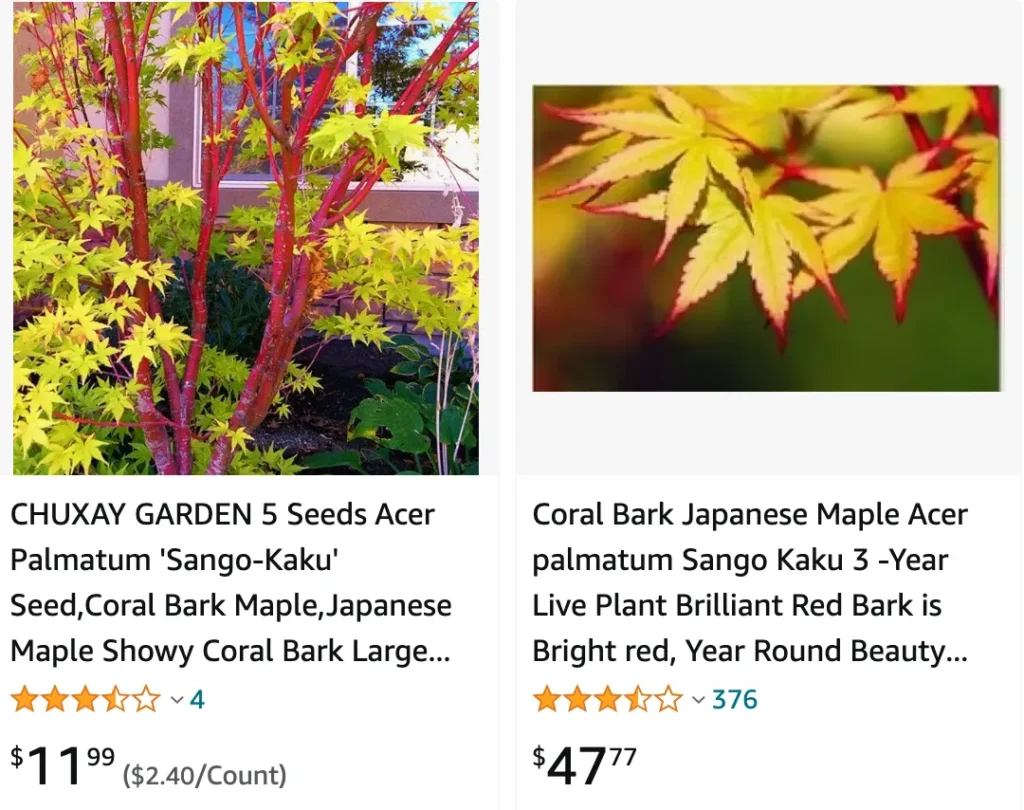
What is Acer Palmatum Sango Kaku?
Ever since I stumbled upon a picture of the Acer Palmatum Sango Kaku, I knew I had to have it in my garden. This stunning Japanese maple captivated me with its vibrant coral bark and delicate foliage. Little did I know, I was about to embark on a rewarding journey of cultivating this captivating specimen.
The Sango Kaku, also known as the Coral Bark Maple, isn’t just visually arresting; it’s surprisingly adaptable. Throughout the seasons, it offers a continuous display of beauty, making it a prized possession for any garden enthusiast. In this article, I’ll share my experiences with this remarkable tree, including planting tips, pruning techniques, and general care considerations.
168 Species in Genus Acer – Maple Tree
How to care for Acer Palmatum Sango Kaku?
Before diving into planting, it’s crucial to understand the Sango Kaku’s ideal environment. Here are some key factors to consider:
- Light: This maple thrives in locations with full sun to partial shade. Aim for at least 6 hours of direct sunlight daily. However, in scorching climates, some afternoon shade can be beneficial.
- Soil: Well-drained soil is paramount. The Sango Kaku tolerates a range of soil types, from slightly acidic to slightly alkaline. If your soil is heavy clay or prone to waterlogging, consider amending it with sand or compost to improve drainage.
- Space: While the Sango Kaku grows at a moderate pace, it can eventually reach a height and spread of 6-8 meters. Choose a location that provides ample space for its future growth.
How to Plant Acer Palmatum Sango Kaku?
Once you’ve identified the perfect spot, it’s time to plant your Sango Kaku:
- Dig a Hole: Dig a hole about two to three times wider than the root ball of your chosen Sango Kaku. Aim for a depth slightly deeper than the root ball itself.
- Loosen the Soil: Loosen the soil around the edges of the hole to encourage root expansion.
- Amending the Soil (Optional): If necessary, amend the soil with compost or organic matter to improve drainage and nutrient content.
- Positioning the Tree: Carefully place your Sango Kaku in the hole, ensuring the root flare (the area where the trunk meets the roots) sits slightly above the surrounding soil level.
- Backfill and Water: Fill the hole with the excavated soil, gently tamping it down to remove air pockets. Water thoroughly to settle the soil and hydrate the roots.
Watering and Mulching Your Sango Kaku
- Watering: During the first year after planting, consistent watering is crucial. Aim to keep the soil consistently moist, but not soggy. As your Sango Kaku matures, it becomes more drought-tolerant. However, during extended dry periods, supplemental watering may be necessary.
- Mulching: Apply a layer of mulch around the base of your Sango Kaku, keeping it a few inches away from the trunk. Mulch helps retain moisture, suppress weeds, and regulate soil temperature.
How to Prune Acer Palmatum Sango Kaku?
Pruning isn’t strictly necessary for the Sango Kaku’s health, but it can enhance its shape and encourage bushier growth. Here are some tips:
- Pruning Time: The ideal time to prune your Sango Kaku is during the late fall or winter months, while the tree is dormant.
- Pruning Techniques: Focus on removing dead, diseased, or overcrowded branches. You can also selectively prune to maintain a desired shape or size.
- Light vs. Heavy Pruning: Light pruning helps maintain the tree’s natural form. Avoid drastic pruning, as this can negatively impact its health and vibrancy.
Additional Care Considerations
Here are some additional things to keep in mind when caring for your Sango Kaku:
- Fertilization: While not essential, a light application of a balanced fertilizer in early spring can promote healthy growth.
- Winter Protection: In particularly harsh winters, young Sango Kakus may benefit from some protection, especially if planted in exposed locations. Burlap or a light shade cloth can be used to shield the tree from strong winds or excessive cold.
- Pests and Diseases: Generally, the Sango Kaku is quite resistant to pests and diseases. However, keep an eye out for common maple problems like aphids, scale, and fungal diseases.
The Alluring Reward: Witnessing the Seasons Change
The true magic of the Sango Kaku unfolds throughout the seasons. In spring, its vibrant green leaves emerge, adding a touch of freshness to the garden. As summer progresses, the foliage maintains its lush green color, offering a cool, shady haven under its canopy. But the real showstopper arrives in autumn. The green leaves transform into a breathtaking display of fiery hues. Reds, oranges, and yellows erupt across the branches, creating a captivating spectacle that rivals any firework display. The contrast between the fiery foliage and the vibrant coral bark is simply mesmerizing.
Winter brings a different kind of beauty. As the leaves fall away, the Sango Kaku’s stunning coral bark takes center stage. The vibrant orange-red hues seem to glow against the winter backdrop, adding a splash of color to the often-dormant landscape. The intricate branching pattern also becomes more prominent, creating a sculptural masterpiece in your garden.
Beyond Beauty: The Joys of Caring for a Sango Kaku
Cultivating a Sango Kaku isn’t just about enjoying its dazzling beauty; it’s about fostering a connection with nature. Witnessing the transformation of this tree throughout the seasons brings a sense of wonder and appreciation for the natural world. The act of caring for the Sango Kaku, from watering and pruning to simply admiring its presence, provides a sense of peace and fulfillment.
Whether you’re a seasoned gardener or just starting out, the Sango Kaku is a rewarding addition to any landscape. With its captivating beauty and adaptability, this Japanese maple offers a continuous display of magic throughout the year. So, if you’re looking for a tree that will bring both visual delight and a connection to nature, consider welcoming the Sango Kaku into your garden. You won’t be disappointed.
If i die, water my plants!



